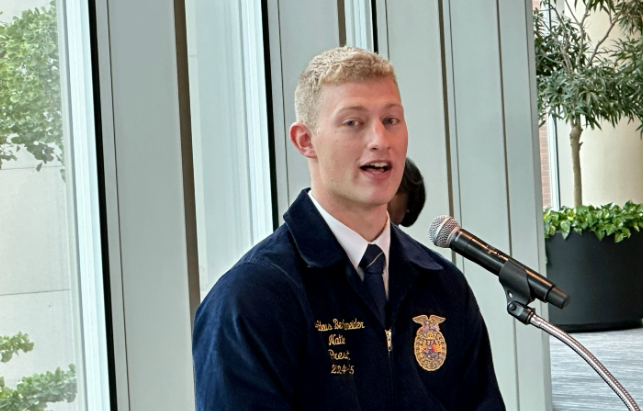
At the 2025 National FFA Convention and Expo in Indianapolis, National FFA President Thad Bergschneider reflected on a whirlwind year representing more than one million members while speaking with senior far and ranch broadcaster Ron Hays. “You can’t go anywhere without meeting somebody,” he said, describing how FFA connects people from all walks of life. “If not an active member, there is always an alumni on a plane who you’re sitting next to… and all of a sudden you hear their story.” Bergschneider emphasized that even those who never wore the blue jacket are only “a few degrees of connection” away from someone who did.
Thad’s own FFA story began reluctantly. “Freshman year of high school, going to pick out ag classes with my dad, and I work up the courage to tell him I don’t think I want to join FFA,” he recalled. “His response was, ‘Too bad.’” Though he came from a farm background of corn, soybeans, and cattle, Bergschneider said, “I didn’t think FFA was where I belonged. I was interested in math and science… in public speaking and policy.” That all changed when he read the FFA Creed and competed in ag sales. “I realized that, oh no, FFA is where I’m meant to be.”
Discussing the evolution of the FFA Creed and the organization’s identity, Bergschneider reaffirmed the group’s agricultural roots. “It’s important to say that FFA is still farming,” he said, “and it’s the veterinarians, the scientists, the chemists, the IT experts, the technologists, the… artificial intelligence specialists, the data learning specialists, who continue to support those endeavors.” His message underscored that the FFA remains grounded in agriculture while embracing the growing world of ag-related science and technology.
Artificial intelligence has been a recurring topic in FFA discussions this year, and Bergschneider cautioned against turning it into a passing trend. “It’s important… to not make it a buzzword,” he explained. “People will point to the moment ChatGPT was introduced and say, ‘That’s when AI began,’ but artificial intelligence has been developed for the past decade.” He pointed to agricultural companies like John Deere that have quietly used AI tools long before the technology dominated headlines, saying, “It’s the continued implementation of machine learning and data techniques that really help farmers in the field.”
When asked about memorable interactions during his travels, Bergschneider shared several impactful encounters. One that stood out involved a student he never met. “His name was Pedro,” he said, “and Pedro’s project was learning how to use a hydrogen engine and replacing the diesel engine within a semi. And I went, holy smokes, this kid’s going places.” He also recalled meeting a Missouri FFA member with a knee disorder who said FFA still made her “feel at home even with this struggle.” To Thad, stories like these capture FFA’s true heart: “High school and middle school students are always looking for a home… and they’re going to find that in FFA.”
Bergschneider also reflected on connecting with industry leaders who support the organization. One memorable visit was with agricultural innovator Harry Stein, whom Thad called “a great example of a captain of industry.” After losing to Stein in ping pong, Bergschneider learned about Stein’s challenges growing up. “He was diagnosed with dyslexia and later autism,” Thad said, “and the only person who really believed in him was an ag teacher.” For Bergschneider, this story illustrates how ag educators and sponsors “continue to help FFA along by making sure that we’re matching our industry standards.”
As his term as national president neared its end, Bergschneider reflected on what FFA had given him. “We wear the FFA jacket to make us better people outside of it,” he said. “When I take off this jacket, what I think I’ve been given is a life of integrity and purpose.” The lessons he carries forward are simple but lasting: “You learn how to shake a hand, you learn how to look someone in the eye, but more importantly, you learn how to do the right thing when no one’s watching.” For Thad Bergschneider, those are the values that define the blue and gold.

















